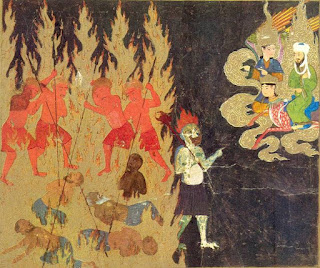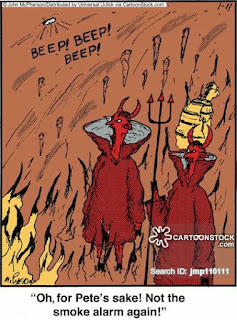
If you know someone who is religious, it is very likely that they are in some denomination of Christianity, like Catholic or Baptist. The basic Christian belief is that God created the Earth and that he sent his son Jesus Christ to die for everyone’s sins. But we’re not here to talk about God or Heaven, but rather the direct opposite: Hell! Or at least the concept thereof. According to Richard Burky of Vision.Org, “The Athanasian Creed…ends with these words: “They that have done good shall go into life everlasting, and they that have done evil into everlasting fire. This is the Catholic Faith, which except a man believe faithfully and firmly, he cannot be saved.” What’s the first thing that comes to mind when you think of Hell? Fire? Brimstone? A red-faced man with horns and goat legs holding a trident? Some people might say that Hell is having to live with your parents despite being 30 years old or having your someone drag you to another Justin Beiber concert. There’s even the timeless phrase, “War is Hell" (something I think all war veterans can agree to). Someone else had a more poetic and complex concept of Hell. I’m referring, of course, to Dante Aleghieri, a famous poet from the Italian Rennaisance. In 1320, he published The Divine Comedy, a long, narrative poem that delivers an allegorical vision of the afterlife. It is divided into three sections: Inferno, Purgatorio, and Paradiso. Since I’ve always been fascinated by The Inferno, which is the most famous of the three sections, we’re gonna look into Dante’s concept of Hell.

In The Inferno, Dante divides Hell into
nine circles based on the seven deadly sins: Limbo, Lust, Gluttony, Greed,
Wrath, Heresy, Violence, Fraud, and Treachery.
Dante had somewhat of a strong political view. He condemns Pope Pietro da Morrone, who resigned as Pope after 161 days in 1294, which for Dante was an insult to both God and the people of Italy. He also condemns Filippo Argenti, a Black Guelph in Italian politics (Dante was a White Guelph). Dante had both political and personal oppositions with; it is widely speculated that Filippo came to possess all of Dante's things when he was exiled in 1302 and may have physical confrontations with Dante (Kelly 1). While writing the Divine Comedy, Dante decided to write in some political beliefs of his into The Inferno by placing each political figure into a circle of Hell. While his concept of Hell follows most of the Christian concept, Vittorio Montemaggi of the University of
Leeds wrote, “Hell, for Dante, is a pit sealed within
the bowels of the earth.” This means, perhaps, that he
believed that Hell is right here on Earth and not in this metaphysical
realm. His concept of Hell isn’t
completely fire and brimstone that the majority of Christians believe. Canto XXII of The Inferno depicts the Ninth Circle (Treachery) as a
frozen wasteland, caused by the freezing winds from Lucifer’s flapping wings
(referred to as “Dis” in The Inferno).

Dante describes how the damned endure their pain “at grief so deep the tongue must wag in vain; the language of our sense, and memory lacks the vocabulary of such pain.” This keeps to the common idea that in Hell, bad souls endure severe and unending torture for all eternity. While Dante may not have been a painter, he definitely uses his words to “paint a picture” of the various forms of Hell. Dante uses an artistic point of view for the different circles and tortures in Hell. In the Seventh Circle, there are three rings for those who’ve committed violence:

Dante describes how the damned endure their pain “at grief so deep the tongue must wag in vain; the language of our sense, and memory lacks the vocabulary of such pain.” This keeps to the common idea that in Hell, bad souls endure severe and unending torture for all eternity. While Dante may not have been a painter, he definitely uses his words to “paint a picture” of the various forms of Hell. Dante uses an artistic point of view for the different circles and tortures in Hell. In the Seventh Circle, there are three rings for those who’ve committed violence:
· -For violence against a neighbor, the damned are
immersed in a river of boiling blood (aka, the River Phlegethon).
· - For violence against self, the damned are
transformed into gnarled and thorny trees “for ‘tis not just to have what one
casts off.”
· -For violence against nature, art, and God, the
damned are forced to walk upon burning sand while fire rains down upon them.


Christianity isn’t the only religion with
Hell; Islam believes there is a burning inferno where the non-believers, or
“infidels”, go to when they die. Burky
writes, “Hell and final judgment are among the
dominant themes of the Qur’an, which warns, “Surely, those who disbelieve in
our revelations, we will condemn them to the hellfire. Whenever their skins are
burnt, we will give them new skins. Thus, they will suffer continuously.” For Buddhists, a “hell” is being reincarnated
over and over again, never to reach nirvana.
The Ancient Greeks developed their concept of Hell as the
Underworld. However, the Anchor Bible
Dictionary explains, “The Greek word Hades is sometimes, but misleadingly,
translated “hell” in English versions of the New Testament. It refers to the
place of the dead but not necessarily to a place of torment of the
wicked dead.” In other words, it’s
a place where the souls of the dead dwell; it is neither a Heaven nor a Hell.




Whether
the idea of Hell is used to lead people on the path of righteousness or simply
a scare tactic developed by crazy people, it has been imbedded into the
cultures across the world. The concept
of Hell varies from culture to culture; while Christianity and Islam have the “hellfire”
concept, other religions, like Judaism, Taoism, and Zoroastrianism, have a
definition or idea of a hell. Burky
wrote how, “The idea of perpetual (or near-perpetual) torment is so prevalent
in the world’s religions and cultures that if you mention “hell,” a certain
concept immediately comes into people’s minds.” A commonly asked question, however, asks: Is there a Hell? Non-religious people often don't believe in a hell. They believe that it is a scare-tactic created by the "religious fanatics" of the church to frighten folks. For them, "hell" can be something as simple as living with a bone disease or having a bad heroin addiction. Hell doesn't have to be a metaphysical idea, but rather a METAPHORICAL idea. As a “lake of fire” for the souls of the
damned or a cool idea for a heavy metal song, everyone has an idea of what Hell
is or can be, religious or not.
"Dante's Inferno: A Trip Through Hell"
Sources:
-The Divine Comedy: Inferno by Dante Aleghieri
-Hell: Origins of an Idea by Richard Burky and Jeanette B. Anderson of Vision-http://www.vision.org/visionmedia/origin-of-hell/41044.aspx
-Dante's Idea of Hell by Vittorio Montemaggi, Matthew Treherne, and Abi Rowson of the University of Leeds-http://www.leeds.ac.uk/arts/info/125125/inferno/1732/2_dantes_idea_of_hell
-10 Real People Condemned To Dante's Inferno by Debra Kelly of ListVerse.com-listverse.com/2016/10/18/10-real-people-condemned-to-dantes-inferno/
Sources:
-The Divine Comedy: Inferno by Dante Aleghieri
-Hell: Origins of an Idea by Richard Burky and Jeanette B. Anderson of Vision-http://www.vision.org/visionmedia/origin-of-hell/41044.aspx
-Dante's Idea of Hell by Vittorio Montemaggi, Matthew Treherne, and Abi Rowson of the University of Leeds-http://www.leeds.ac.uk/arts/info/125125/inferno/1732/2_dantes_idea_of_hell
-10 Real People Condemned To Dante's Inferno by Debra Kelly of ListVerse.com-listverse.com/2016/10/18/10-real-people-condemned-to-dantes-inferno/
Comments:
-https://cophilosophy.blogspot.com/2017/04/1st-installment-section-8-ivana-deveaux.html?showComment=1493000372018#c9117510753484559750
-https://cophilosophy.blogspot.com/2017/04/batman-superman-and-philosophy.html?showComment=1493000790564#c1573803661740867849
"If you know someone who is religious, it is very likely that they are in some denomination of Christianity, like Catholic or Baptist" - if you were born and raised in the AMerican Bible Belt. It's important not to reduce "religion" to its local expression, or to forget all the others.
ReplyDelete"Hell is right here on Earth" - as the poet says, thinking (and acting, he should have added) can make of heavan a hell and vice versa.
"Non-religious people often don't believe in a hell" - plenty of religious or "spiritual" people too.
For some of us, grading can be hell. That's why we're so grateful for good students!
Nice job with the visual elements, Latham!